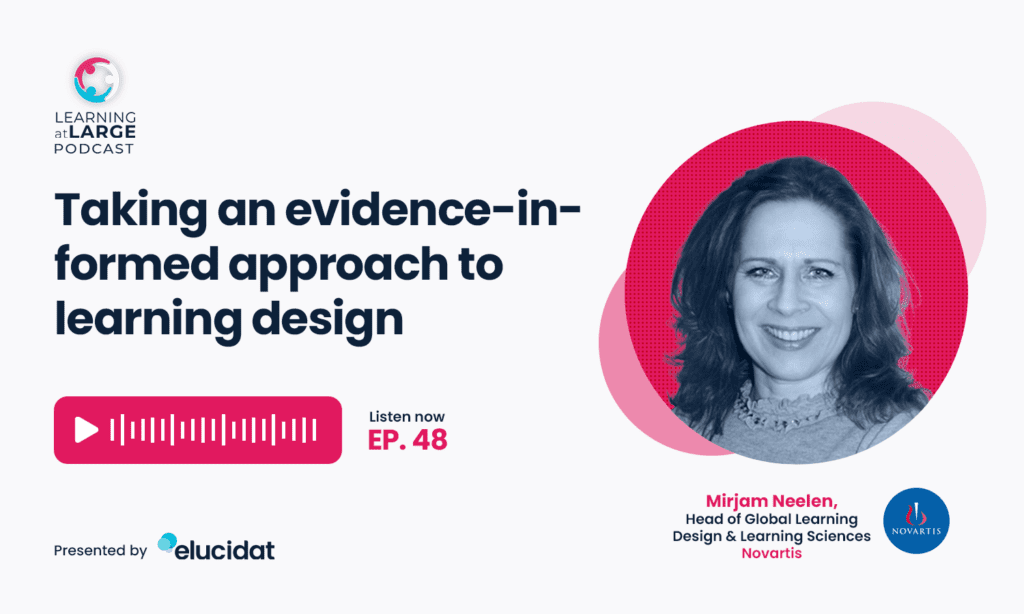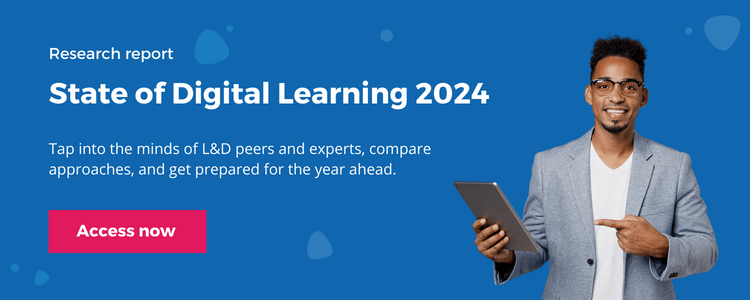Evidence-Informed Learning: Mirjam Neelan
L&D is too often based on fads. The latest trends are quickly adopted without evaluation. The results are hit or miss. If you’re going to make a real impact, Mirjam Neelen, Head of Global Learning Design & Learning Sciences at Novartis, believes you need to start with the evidence. Hear how she takes an evidence-informed approach to learning design. Discover how you can look beyond the latest trends to focus on what really matters.

Top tips for delivering evidence-informed learning experiences
Don’t have time to listen now? Here are some top tips from Mirjam:
- Stop jumping to solutions; start getting informed: Steaming ahead without evaluation limits your effects. Take an evidence-informed approach to creating training to improve performance.
- Interrogate your evidence: Combine research findings with your own organization’s data. Don’t take anything at face value. Dig in to identify what this evidence really tells you.
- Forget fads; focus on what matters: Stop rapidly adopting the latest trend. Slow down to focus on solving the real business problems.
- See skills as part of a performance enabling package: Looking at skills in isolation loses any context. Understand the full package that people need to succeed.
1. Stop jumping to solutions; start getting informed
When Mirjam moved from the academic world of learning science research to L&D in large global organizations, she was struck by one big difference. Used to looking for scientific evidence, she now saw decisions made and solutions designed with little critical evaluation.
It was this huge blind spot that made her reach out to, and start working with, Paul A. Kirschner. Their book, Evidence-Informed Learning Design, makes the case for L&D gathering, assessing, and using evidence to support learning that creates a measurable difference in employee performance and business success.
“I think we do way too much stuff that is, in the end, quite low value. And I’m hoping that we’ll have the courage to do less, and really focus on the things that have high value, high impact…Maybe it’s because I started with an academic background, but I’ve always looked for what we know to be true, and how we can make the best-informed decisions. I’ve always had that hat on – that product lens. And when I moved into a job, there was none of it.”
2. Interrogate your evidence
Adapting a scientific approach to a corporate learning context means opening up to different kinds of evidence. As well as looking to academic research, it’s critical to find out what does and doesn’t work for your organization. Mirjam says, use your expert knowledge and experience. Listen to your stakeholders. Explore your systems data.
Don’t take things at face value. Dig into what this evidence really tells you. If a stakeholder says they need elearning and it needs to be launched in two weeks, ask why. Why does it have to be elearning? Why is it needed in two weeks? Explore how they got to these decisions. Move past the pressures and obstacles that may be obscuring the stakeholder’s real evidence of need.
“A good day for me is when I work with business clients who are really focused on what they’re trying to achieve, and willing to think through what is it that our people need to be able to change or to be able to improve what they do on the job. So, to really think beyond training. If they say, ‘Oh, yeah, I haven’t thought about that. I was just thinking about the training, but actually, that’s not enough.’ Then that’s good. I can help them with that.”
3. Forget fads; focus on what matters
Whether it’s new buzzwords or cutting-edge tech, learning professionals can often be led by the latest trends. These are rapidly adopted with the fear that, if you don’t move fast, you’ll be left behind.
For Mirjam, a false sense of urgency and too much focus on fads distracts from what really matters: solving business problems. Instead of rushing ahead with what you think is the solution, start with some needs analysis. Once you’ve identified the real need, take another look at your solution. Is adopting this latest trend really a good idea? Do you need to act so quickly? Is good enough really good enough?
“I can only hope that the trend goes towards solving real problems. Really helping people to improve how they do their jobs. Doing less low value stuff, and more high value stuff. What I’m worried about is that we seem to put old wine in new bottles. We’re busy finding shiny new terms or toys, or very focused on trends. But who cares about the trends? Let’s just focus on what matters. Let’s make that a trend! That would be exciting to me.”
4. See skills as part of a performance-enabling package
Faced with widening skill gaps, many businesses are moving to become skills-based organizations. But being too narrowly focused on skills can lead to blind spots.
Mirjam is clear that looking at skills in isolation loses vital real-world context. After all, skills alone are not enough to get a job done. It also requires knowledge, as well as the right attitude and behaviors. Mirjam describes this combination as a performance-enabling package. L&D is key to ensuring people can develop the full package they need to succeed in their role.
“When we think about the context in which work takes place, it quickly becomes more complicated. Even if you develop a skill here and there, if you need to move to another context in which you need to combine them, it’s a big assumption to think that people are able to do that, to connect the dots between all these different skills that they might have learned out of context and separately, and then suddenly they need all together in this new context. That’s not going to happen.”
A quick recap
Want to make sure your learning and development decisions are evidence-based? Mirjam has four strategies for embracing evidence-informed learning design.
- Stop jumping to the solution and start assessing the evidence.
- Interrogate your organization’s evidence to get to the real learning needs.
- Don’t fall for fads, focus on what matters: solving the business problem.
- Look at skills are part of a wider performance enabling package.
Want to find out more? Check out the full podcast.
About Mirjam
After over 15 years’ of industry experience working for organizations like T-Mobile, Google and Accenture, Mirjam became Head of Global Learning Design & Learning Sciences at Novartis in 2020. In the same year, her book Evidence-Informed Learning Design was published.
You can find out more and get connected with Mirjam on LinkedIn.
On Mirjam’s reading lists
Find out which books have inspired Mirjam’s thinking about evidence-informed learning design.
Learning Experience Design: How to Create Effective Learning that Works, Donald Clark
Bringing lots of research and models together, this practical guide provides a wealth of knowledge and insights to help you use learning techniques with impact.
This book explores the findings of some seminal research on how we learn. Find out how you can use this evidence to design learning experiences that are effective, efficient, and enjoyable.
Looking for more reading tips? Check out our book blog.
Learn more from like-minded learning experts
Interested to hear more from Mirjam as well as other learning experts and your L&D peers? The State of Digital Learning Report is the place where you can tap into the minds of your L&D peers and learning experts, compare approaches, and get prepared for the year ahead.
